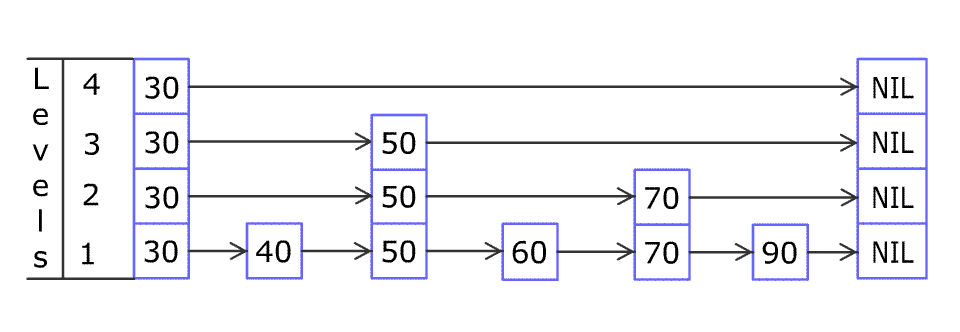1337. Design Skiplist¶
Difficulty: Hard
LeetCode Problem View on GitHub
1337. Design Skiplist
Hard
Design a Skiplist without using any built-in libraries.
A skiplist is a data structure that takes O(log(n)) time to add, erase and search. Comparing with treap and red-black tree which has the same function and performance, the code length of Skiplist can be comparatively short and the idea behind Skiplists is just simple linked lists.
For example, we have a Skiplist containing [30,40,50,60,70,90] and we want to add 80 and 45 into it. The Skiplist works this way:

Artyom Kalinin [CC BY-SA 3.0], via Wikimedia Commons
You can see there are many layers in the Skiplist. Each layer is a sorted linked list. With the help of the top layers, add, erase and search can be faster than O(n). It can be proven that the average time complexity for each operation is O(log(n)) and space complexity is O(n).
See more about Skiplist: https://en.wikipedia.org/wiki/Skip_list
Implement the Skiplist class:
Skiplist()Initializes the object of the skiplist.bool search(int target)Returnstrueif the integertargetexists in the Skiplist orfalseotherwise.void add(int num)Inserts the valuenuminto the SkipList.bool erase(int num)Removes the valuenumfrom the Skiplist and returnstrue. Ifnumdoes not exist in the Skiplist, do nothing and returnfalse. If there exist multiplenumvalues, removing any one of them is fine.
Note that duplicates may exist in the Skiplist, your code needs to handle this situation.
Example 1:
Input ["Skiplist", "add", "add", "add", "search", "add", "search", "erase", "erase", "search"] [[], [1], [2], [3], [0], [4], [1], [0], [1], [1]] Output [null, null, null, null, false, null, true, false, true, false] Explanation Skiplist skiplist = new Skiplist(); skiplist.add(1); skiplist.add(2); skiplist.add(3); skiplist.search(0); // return False skiplist.add(4); skiplist.search(1); // return True skiplist.erase(0); // return False, 0 is not in skiplist. skiplist.erase(1); // return True skiplist.search(1); // return False, 1 has already been erased.
Constraints:
0 <= num, target <= 2 * 104- At most
5 * 104calls will be made tosearch,add, anderase.
Solution¶
class Skiplist {
private TreeSet<Integer> set;
private HashMap<Integer, Integer> map;
public Skiplist() {
set = new TreeSet<>();
map = new HashMap<>();
}
public boolean search(int target) {
if (set.contains(target)) return true;
return false;
}
public void add(int num) {
map.put(num, map.getOrDefault(num, 0) + 1);
set.add(num);
}
public boolean erase(int num) {
if (!set.contains(num)) return false;
map.put(num, map.getOrDefault(num, 0) -1);
if (map.getOrDefault(num ,0) == 0) {
map.remove(num);
set.remove(num);
}
return true;
}
}
/**
* Your Skiplist object will be instantiated and called as such:
* Skiplist obj = new Skiplist();
* boolean param_1 = obj.search(target);
* obj.add(num);
* boolean param_3 = obj.erase(num);
*/
Complexity Analysis¶
- Time Complexity:
O(?) - Space Complexity:
O(?)
Approach¶
Detailed explanation of the approach will be added here